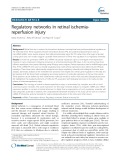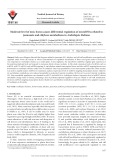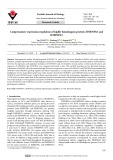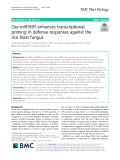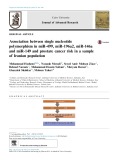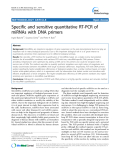
Post-transcriptional level
-
Abnormal DNA methylation is observed as an early event in breast carcinogenesis. However, how such alterations arise is still poorly understood. microRNAs (miRNAs) regulate gene expression at the posttranscriptional level and play key roles in various biological processes.
 21p
21p  vibransone
vibransone
 28-03-2024
28-03-2024
 4
4
 2
2
 Download
Download
-
Retinal function is ordered by interactions between transcriptional and posttranscriptional regulators at the molecular level. These regulators include transcription factors (TFs) and posttranscriptional factors such as microRNAs (miRs).
 15p
15p  vinarcissa
vinarcissa
 21-03-2023
21-03-2023
 4
4
 1
1
 Download
Download
-
Earlier our colleagues detected that the genes related to jasmonate (JA), ethylene, and cell wall modification were significantly regulated under boron (B) toxicity in wheat. Determination of regulation mechanisms of these novel genes under B toxicity is very important in Arabidopsis thaliana as a model plant. As key regulators, the microRNAs (miRNAs) regulate gene expression at the posttranscriptional level and respond to numerous abiotic stresses in plants.
 6p
6p  tudichquannguyet
tudichquannguyet
 29-11-2021
29-11-2021
 9
9
 1
1
 Download
Download
-
The fine-tuned regulation of the Halliwell–Asada cycle (ascorbate–glutathione pathway) in Arabidopsis thaliana under boron (B) toxicity was shown in our previous report. In this study, we investigated the expression levels of some members of the glutathione S-transferase (GST) superfamily, such as phi (GSTF2, GSTF6, GSTF7, and GSTF8), tau (GSTU19), and zeta (GSTZ1) classes in Arabidopsis thaliana that were exposed to 1 mM boric acid (1B) and 3 mM boric acid (3B).
 9p
9p  tudichquannguyet
tudichquannguyet
 29-11-2021
29-11-2021
 14
14
 1
1
 Download
Download
-
Heterogeneous nuclear ribonucleoprotein (HNRNP) A1 and A2 are the most abundant HNRNPs with nearly identical functions, and play important roles in regulating gene expression at multiple levels (i.e. transcription, posttranscription, and translation). However, the expression and regulation mechanism of HNRNPA1 and A2 themselves remain unclear. In this study, the amino acid sequences of HNRNPA1 and HNRNPA2 were compared and found to have 78% and 86% homology in key functional domains.
 10p
10p  thiencuuchu
thiencuuchu
 27-11-2021
27-11-2021
 9
9
 1
1
 Download
Download
-
With rising global temperature, understanding plants’ adaptation to heat stress has implications in plant breeding. MicroRNAs (miRNAs) are small, non-coding, regulatory RNAs guiding gene expression at the posttranscriptional level.
 16p
16p  visilicon2711
visilicon2711
 20-08-2021
20-08-2021
 14
14
 1
1
 Download
Download
-
Long non-coding RNAs (lncRNAs) play crucial roles in gene regulation at the transcriptional and posttranscriptional levels. LncRNAs are belonging to a large class of transcripts with ≥200 nt in length which do not code for proteins, have been widely investigated in various physiological and pathological contexts by highthroughput sequencing techniques and bioinformatics analysis.
 14p
14p  vijeeni2711
vijeeni2711
 30-06-2021
30-06-2021
 14
14
 1
1
 Download
Download
-
A large body of evidence shows that miRNA regulates the expression of its target genes at posttranscriptional level and the dysregulation of miRNA is related to many complex human diseases. Accurately discovering disease-related miRNAs is conductive to the exploring of the pathogenesis and treatment of diseases.
 14p
14p  vicolorado2711
vicolorado2711
 23-10-2020
23-10-2020
 10
10
 0
0
 Download
Download
-
Despite increasing characterization of DEAD-box RNA helicases (RHs) in chloroplast gene expression regulation at posttranscriptional levels in plants, their functional roles in growth responses of crops, including rice (Oryza sativa), to abiotic stresses are yet to be characterized.
 11p
11p  viharuno2711
viharuno2711
 24-04-2020
24-04-2020
 9
9
 0
0
 Download
Download
-
MicroRNAs (miRNAs) are small non-coding RNAs that regulate gene expression at the posttranscriptional level in eukaryotes. In rice, MIR7695 expression is regulated by infection with the rice blast fungus Magnaporthe oryzae with subsequent down-regulation of an alternatively spliced transcript of natural resistanceassociated macrophage protein 6 (OsNramp6). NRAMP6 functions as an iron transporter in rice.
 16p
16p  viharuno2711
viharuno2711
 21-04-2020
21-04-2020
 6
6
 1
1
 Download
Download
-
MicroRNAs (miRNAs) play an important role in regulating gene expression at the posttranscriptional level and are involved in numerous physiological processes. Accumulating evidence suggests that single-nucleotide polymorphisms (SNPs) in human miRNA genes may affect miRNA biogenesis pathway and influence the susceptibility to several diseases such as cancer. The present study aimed to evaluate the impact of miR-499 rs3746444, miR-196a2 rs11614913, miR-149 rs2292832, and miR-146a rs2910164 polymorphisms on prostate cancer (PCa) risk in a sample of Iranian population.
 8p
8p  kequaidan1
kequaidan1
 16-11-2019
16-11-2019
 25
25
 2
2
 Download
Download
-
important regulators of biological processes in animals and plants. MiRNAs regulate gene expression at the posttranscriptional level by binding to mRNAs and either inhibit translation or modify the stability of the mRNA. Due to the important biological role of miRNAs it is of great interest to study their expression level in the cells. Furthermore, miRNAs have been associated with cancer and other diseases [1] and miRNA expression can help in the diagnosis and prognostic of human disease [2,3].
 11p
11p  zingzing09
zingzing09
 24-04-2013
24-04-2013
 50
50
 3
3
 Download
Download
-
Our understanding of the importance of noncoding RNA molecules is steadily growing. One such important class of RNA molecules are microRNAs (miRNAs). These tiny RNAs fulfi ll important functions in cellular behavior by infl uencing the protein output levels of a high variety of genes through the regulation of target messenger RNAs. Moreover, miRNAs have been implicated in a wide range of diseases. In pathological conditions, the miRNA expression levels can be altered due to changes in the transcriptional or posttranscriptional regulation of miRNA expression.
 354p
354p  thienbinh1311
thienbinh1311
 13-12-2012
13-12-2012
 60
60
 5
5
 Download
Download
-
Phát triển là quá trình kiểm soát sự biểu hiện gen, quá trình điều hòa phức tạp về cơ chế, cơ bản có 5 mức độ: 1- Sự xoắn của NST (Chromatin Packing) 2- Kiểm soát sự phiên mã (Transcriptional Control) 3- Điều hòa hậu phiên mã (Posttranscriptional) [Nhân tế bào (Nuclear levels)] 4- Kiểm soát sự giải mã (Translational Control) 5- Điều hòa hậu giải mã (Posttranslational Control) [Cytosol (Cytoplasmic levels)] Sự điều hòa phiên mã bởi những phân tử protein,yếu tố phiên mã (transcription factors -TF). Các phân tử protein này luôn hiện diện trong tế bào và bám...
 62p
62p  bichtram1910
bichtram1910
 22-05-2012
22-05-2012
 245
245
 36
36
 Download
Download
CHỦ ĐỀ BẠN MUỐN TÌM









